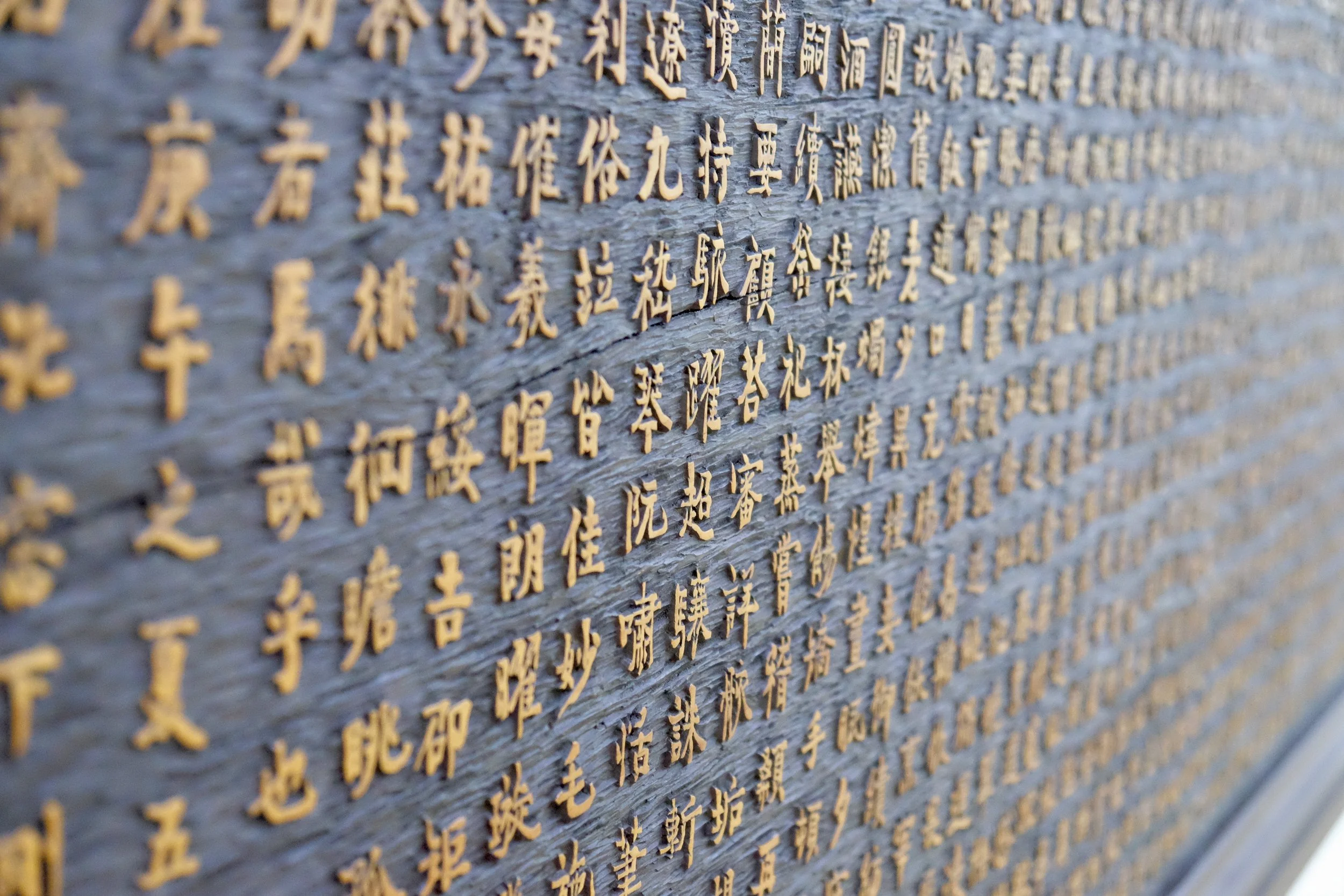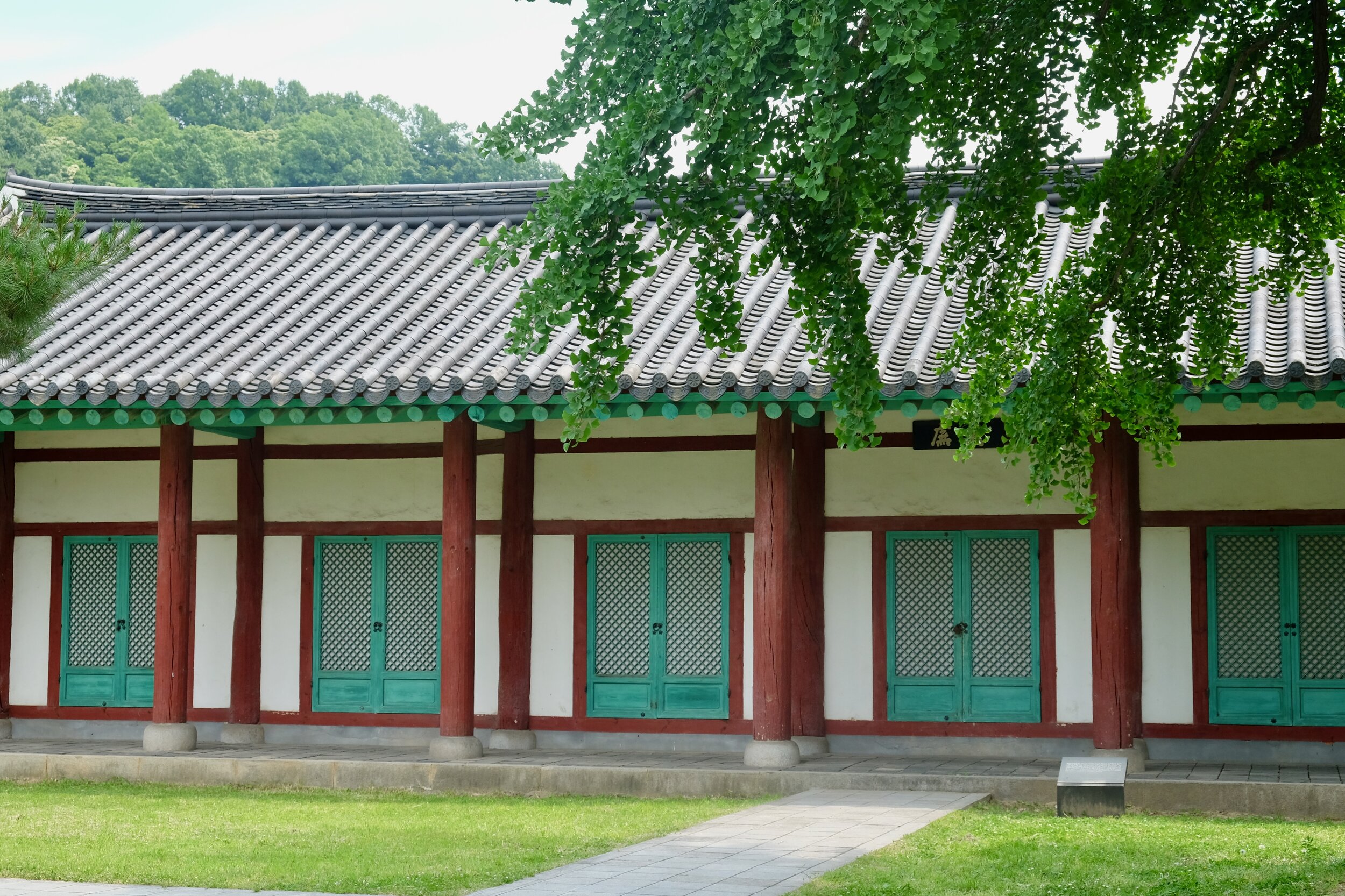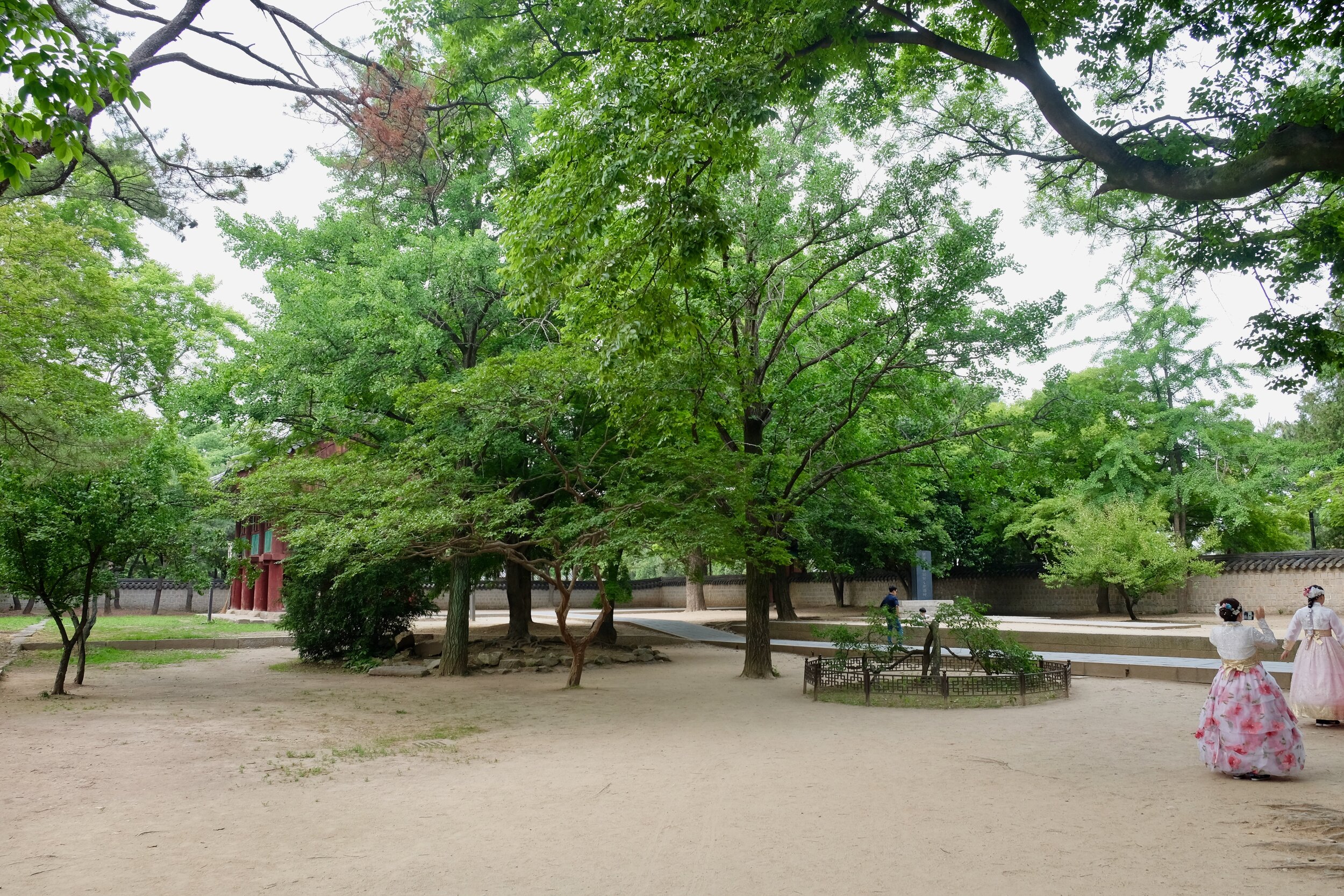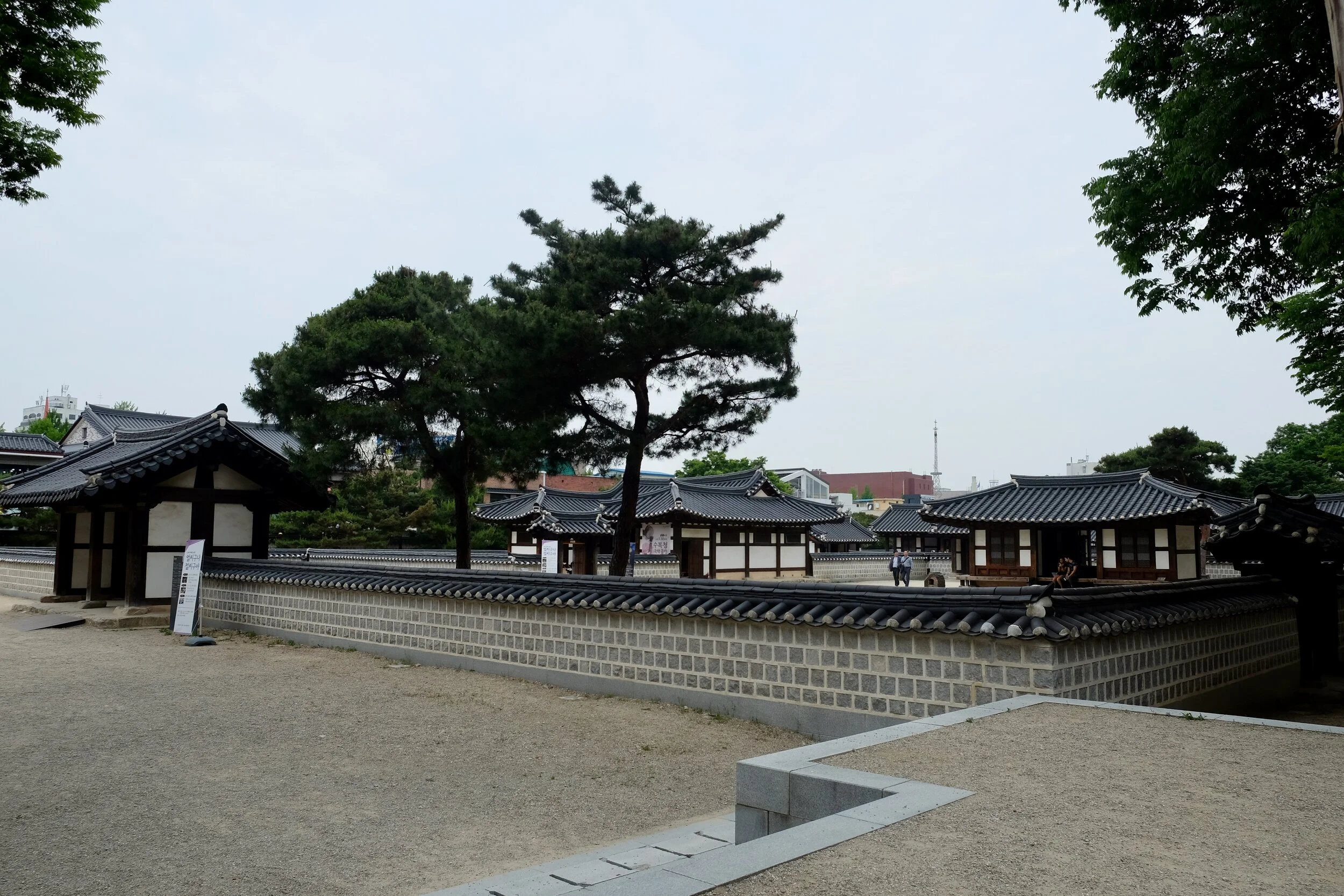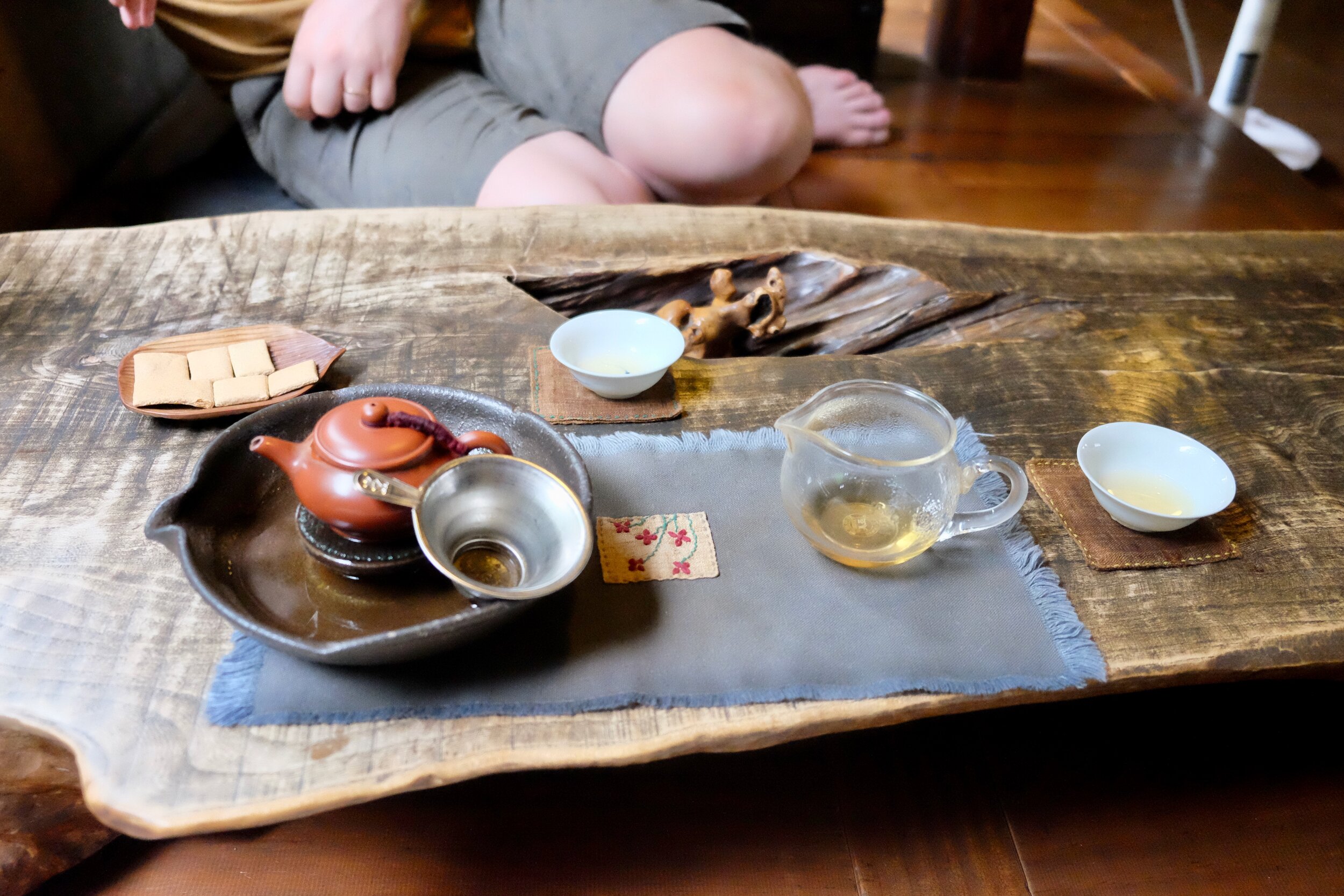The title of this blog post will become clear soon enough.
But first, a public service announcement. Sleeping in a traditional hanok during summer WILL trigger your (Jess’s) severe sweating problem, for it is like living in a furnace. The air just stood like a heavy cloud above our bodies until finally, we caved and turned the air conditioning on. Living in Germany has made us anti-AC like the rest of the population, and as we felt the stuffiness instantly disappear, we wondered why we waited so long to do something about it.
The hanok owner knocked on our door and offered us a tray of cup noodles, apple slices, and mugs of coffee, which we cheerfully consumed in the courtyard. Because today was a rest day, we enjoyed the rare luxury of sitting for a bit and catching up on news from around the world.
Our first stop for today was the Gangam Calligraphy Museum, located at the southernmost border of the hanok village. Stored inside are wonderful examples of writing from some of Korea’s best known calligraphers, and much of the work is that of Song Seongyong, a reputed maker of temple name-boards in dynastic times. There’s also pieces here from several former Korean presidents, as it’s a ritualistic pastime that people of a certain generation enjoy doing.
While early Korean calligraphy was written in Chinese characters, including Hanja, modern Korean calligraphy may be written using Hangul, the native Korean alphabet. The five major types of Korean Hanja calligraphy are:
Jeonseo - seal script
Choseo - cursive script
Haeseo - block script
Haengseo - semi-cursive script
Yeseo - official script
There is a short documentary on YouTube that explains the process and history in greater detail:
Gangam Calligraphy Museum, open daily 10am- 5pm, free entry.
Using gigantic clay pots for fermenting kimchi, exactly how the Koreans have done it for thousands of years.
After that, we moved onto the Jeonju Hyanggyo, a former Confucian academy. Present here since 1603, and still housing a few of the original buildings, it holds a certain air of contemplation and sees a surprisingly low number of visitors - we were the only ones walking around for an hour before another group showed up. Most notable are a number of large ginkgo trees, a couple of which are actually older than the academy itself. It’s worth visiting the hyanggo just to be in the presence of such majesty.
We were also fortunate to come across a calligraphy class in session, filled with old men who were dutifully sitting in rows perfecting their lettering. It was a heartwarming sight to see, and reminded Jess of something her father once said a couple years ago - that at 60, he still felt as if he wasn’t done learning yet. His mind was active and his curiosity was in no way satiated.
Any society who encourages and provides the means for people to keep their minds active in their golden years has to be a good one in our books.
A beautiful spot to take your engagement photos.
Since sleep had eluded us for most of last night due to the unbearable heat, we jumped at the opportunity to hang out at Cafe You for a spot of quiet time. It was still early and the city was yet to fully come to life, and the beanbags on the patio outside kept beckoning us to come over and take a nap. Who were we to say no?
Neil wanted to try Jeonju’s famed bibimbap already for lunch, but we were struggling to find a place that didn’t have horrendous touristic prices. The village itself was proving to be a fruitless hunt, so we stepped outside of it again to find something more reasonable. Which, to Neil, presented itself in the form of what looked like an abandoned building that just happened to have a restaurant on the ground floor. It was like something out of The Walking Dead, and only with Neil’s solemn promise that if anything befell her, he would take sole responsibility, did Jess reluctantly walk in.
She shouldn’t have worried. We were immediately greeted and served after the usual order pantomime, and the cherry on top of the cake was when the owner took it upon herself to mix up Neil’s bibimbap for him, assuming (correctly) that he had no idea what he was doing. She spoke to him in Korean the whole time, explaining her methods, and Neil just looked at her with love in his eyes and swooned.
All this for 18,000 won.
To help digest our midday feed, we walked to Gyeonggijeon at the northern part of the hanok village. It is a park-like shrine area full of ornate buildings, a museum, and beautiful trees - no doubt quite a sight in the autumn.
It was built in 1410 to preserve a portrait of King Taejo, the first leader of the famed Joseon dynasty and native of Jeonju, who had died two years previously after arguably the most productive reign in Korea’s long regal history. The portrait shows Taejo resplendent in an embroidered robe, against a pale yellow background, and sits proudly in a hall to the rear of the complex. It is surrounded by portraits of other members of his family, who were only officially made royals after Taejo’s death, a move that gave posthumous legality to his bringing down of the Goryeo dynasty.
Open daily, 9am-7pm, 1,000 won per person.
Here he is in all his majestic glory.
Not quite the same effect.
There was one thing we had read about previously that we really wanted to make time to do today, and that was to participate in a traditional tea ceremony. Thanks to another person’s account of his visit to Jeonju, we were able to find the Gyodong Tea Garden, which is a hidden oasis inside the village.
It was like stepping into another world. The proprietor, an old man dressed in traditional garb, spoke perfect English and brought us to our wooden hewed floor table. Menus are provided but it’s best if you just ask him directly for recommendations, as this is someone who clearly knows his craft and has spent the majority of his life perfecting the art of tea. If Hogwarts had A-levels for tea, he would be teaching it.
He then brought over a tray with the necessary accoutrements and walked us through the process of pouring the hot water and steeping the tea with precise measurements for one cup each at a time. This forces you to drink slowly and enjoy the deep and complex flavour.
Then, as quickly as he appeared with the goods, he then disappeared and left us alone for the rest of the hour. We were seated next to the window, where we could see the bonsai garden outside and hear the water trickling in the pond. If it wasn’t rude to do so, it would have been tempting to stretch out on the cushion and take another nap - that’s how relaxing this whole thing was.
If you do nothing else here, please make sure to visit this place. This was by far one of the most special moments of our entire journey. There’s nothing else like it, and it’s unlikely that we will experience something like this again.
Gyodong Tea Garden, 64-7, Gyo-dong, Wansan-gu, Jeonju, Jeollabuk-do, South Korea.
It was nearing dinner time, so we had a couple drinks at a rooftop cafe across the street from the main shrine, where we got an amazing bird’s eye view of the grounds. Then it was onto bibimbap round two at the restaurant next door - it was Jess’s first of the trip (since she’s a fake Korean, she doesn’t like bibimbap either) and even she had to admit that it was feckin tasty. The thing they do here that’s different to other parts of the country is add beef tartar instead of cooked beef, which enhances the dish tremendously.
Located on 60-2 Jeon-dong, Wansan-gu, Jeonju-si.
YUM.
We move on tomorrow, but will always remember this town fondly. From food to people, sights and sounds, it was a deliverance of the best that Korea has to offer.
Also - rest day? What’s that?
